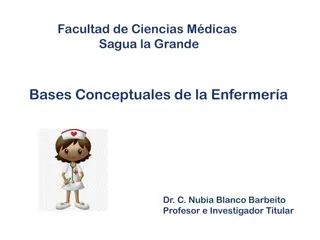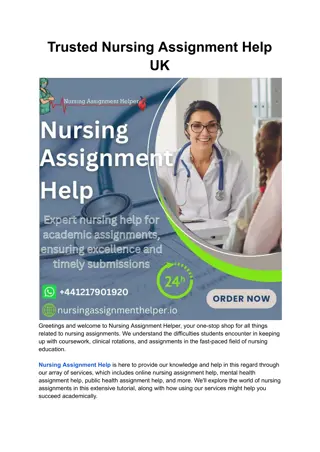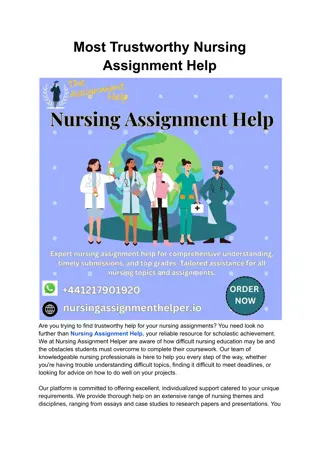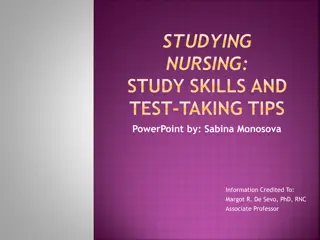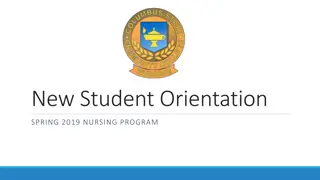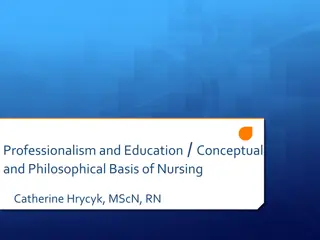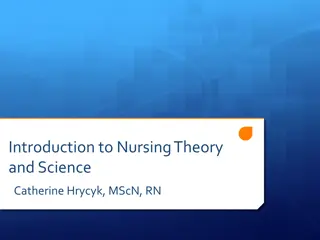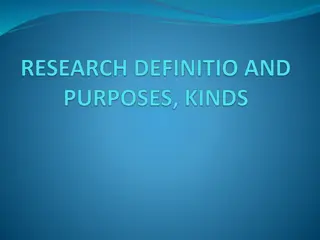Essential Nursing Concepts Review
This content covers a wide range of essential nursing concepts such as proper management of catheter bags, blood pressure reporting guidelines, application of elastic stockings, potential health issues post-surgery, diabetic foot care, elderly patient care, warm pack application, respiratory conditions, tracheostomy care, and surgical preparation, wound care, and pressure ulcer prevention. Important procedures, protocols, and patient care considerations are discussed in detail to enhance nursing knowledge and skills.
Download Presentation

Please find below an Image/Link to download the presentation.
The content on the website is provided AS IS for your information and personal use only. It may not be sold, licensed, or shared on other websites without obtaining consent from the author.If you encounter any issues during the download, it is possible that the publisher has removed the file from their server.
You are allowed to download the files provided on this website for personal or commercial use, subject to the condition that they are used lawfully. All files are the property of their respective owners.
The content on the website is provided AS IS for your information and personal use only. It may not be sold, licensed, or shared on other websites without obtaining consent from the author.
E N D
Presentation Transcript
Quiz 3 Review Drain from catheter bag must not touch anything- WHY? Where is the drain (pg 399) What blood pressure would you report? (pg 484) Systolic 90mm hg or higher but lower then 120. Diastolic 60mm hg or higher but lower than 80. Is 120/80 normal? Is 118/58? Is 126/78? How far to ambulate? Per care plan vs as tolerated Do you always need a STERILE container for specimen? When do you label a specimen bottle and why? Remember an average of 70% on the quizzes is required to finish the class.
32. Mrs. Operation has returned from surgery and elastic stockings are ordered. Why? Explain how to apply elastic stockings. (pg 570-571) 33. Mrs. Oops has just returned from surgery. She has a very low blood pressure, a rapid weak pulse, her skin is cold and pale. She is restless and thirsty. What might be happening and why? (pg 582) 33B. Ms. Lame is a diabetic. She has a sore or ulcer on her foot that won t heal. Why does this happen easily to diabetics? What should you do daily to help prevent a big problem and what should you NOT cut on a diabetic s foot? Pg 581 34 .Mr. Sam is elderly, fragile, and has trouble moving himself. He has poor nutrition and is very thin. What is he at risk for? What measures will help prevent this problem? (pg 596 + 597 ) 35. Mrs. Freeze needs a dry warm pack applied. How warm is safe? How often should you check on her while the heat is applied? What does warmth do to blood vessels? (pg 609) Megan 36A. Miss Wheezy has hypoxia due to hypoventilation. What does this mean? What symptoms might she have? (pg 616 36B. Mr. Windbag has been told he needs to deep breathe and cough regularly after his surgery. Why will this be good? What will it prevent? Define Atelectasis. Pg 621 37. Ms. Smith has a tracheostomy. She needs to get a shower then wants to go outside to walk. What do you need to do to keep her safe? Pg 633
Surgery Raise your hand if you have ever had any surgery? Preparation: Sterilize skin? Surgical site marked before what? Why are coughing/deep breathing important post op? Thrombus VS Embolus-what is the difference? Within how many hours of surgery should a person void? (pee-see pg 574) Why do we get people up right away after surgery?
Wound Care Which way do you pull to remove tape on a dressing and why? Internal hemorrhage ssx pg 582? Learn the wound types, causes, vocabulary 576- 77 Wound appearance-what spells trouble? Box 33-5 on page 584 Types of dressings 586 Dressings Box 33-6 on page 587
Pressure Ulcers What vital element is squeezed out of the area where the ulcer forms? What are the risk factors-page 596 How do we prevent ulcers? Box 34-3 page 598 Clock system-page 599 Why will it be difficult to keep an ulcer on the buttock from a serious infection?
Heat and Cold Applications Heat dilates and brings fluid to the area Cold constricts and decreases fluid in the area Study boxes on page 609 and learn the temps! Meeting Oxygen Needs Abnormal respirations-page 616 What is the normal reading for pulse oximeter? (618) Positioning, deep breathing, spirometry 620-623 Oxygen-equipment, humidification, safety (624-5) Your role with oxygen (box 36-3 pg 629)
Respiratory Therapy Airways-intubation, patent or open airway May be unable to speak Suctioning and cleaning responsibilities depend on where you work Mechanical ventilation and Chest tubes-care and safety
A 20-year-old junior nursing student, Emily, was excited to be in her pediatrics rotation. She had always wanted to be a pediatric nurse. Emily was caring for Tommy, a three-year-old patient in a major academic medical center s pediatric unit. Tommy was receiving chemotherapy for leukemia. He was a happy little guy who was doing quite well and Emily enjoyed caring for him. Emily knew he would likely be going home soon, so when his mom went to the cafeteria for a cup of coffee, Emily asked him if he minded if she took his picture. Tommy, a little ham, consented immediately. Emily took his picture with her cell phone as she wheeled him into his room. When Emily got home that day she excitedly posted Tommy s photo on her Facebook page so her fellow nursing students could see how lucky she was to be caring for such a cute little patient. Then she told her room mate about the 3-year-old leukemia patient who is bravely receiving chemotherapy. She was careful not to use his name. What if the story was the same but the client was an adult?
Common myths Posts are not confidential or private even if sent specifically to an individual Deletion is never final It is NOT ok to discuss a client just because you do not use his name Even with permission, the result may be far more public than you or the person intended See the web link social media ethics
Have a great Spring Break! Our next online session is Tuesday March 22nd We will go over skills week and other info Module 4 quiz is also that week. Check the schedule for due dates-there are no due dates during spring break after you finish chapter 38. 39-40 are due Monday the 21st.
Rehabilitation Assistive devices pg 642 Rehabilitation is about the whole person and restoring the highest level of function and focused on the abilities or strengths a person has. It is about allowing the person to do as much as possible
Hearing, Vision, Speech-disorders With visual impairment-do not change the room or personal items, they are memorized Use words Hearing Impaired and Visually Impaired Aphasia (brain) vs Apraxia (mouth) Dysphasia vs Aphasia Mr. Jones is visually impaired. It is time for him to walk to the dining room and have dinner. How will you help him get there (662) and how will you assist with his meal? (pg 661)
Cancer, Immune SYS, Skin Mrs. Jones is having radiation therapy-as her care giver, what safety measures do you need to use to protect yourself and others? (pg 672) Why don t health care providers put this equation together? HIV ELDERS
Nervous and Musculoskeletal SYS CVA = Cerebrovascular Accident = Stroke Why would high blood pressure (Hypertension) increase the risk for stroke? Warning signs for stroke (pg 681) Hemi, para, quadra or tetra - plegia Ms. Betty had a hip replacement. What will you do as you care for her to protect that new hip? (page 693)
Cardiovascular What is another name for Myocardial Infarction? Explain what heart failure is and why it happens. (701) How does pulmonary edema result from a heart attack? (701)
Tuberculosis Caused by a bacteria spread through the air Enters the body through the lungs but can affect the kidney s, joints, bones, and more TB infection-person has the germ in their body, their skin test is positive, but they are not sick or able to spread TB TB disease (active TB)-person is SICK, weight loss, night sweats, bloody sputum AND they can infect others with TB who share their air Multi drug resistant TB comes from people not completing their antibiotics
Candidate Handbook Read the booklet well before the exam-not just the skills Sample questions generally more basic information than our class READ all of What to expect in the skill test You will be given 5 skills one of which is hand washing Correct yourself if you forget or make a mistake-tell the evaluator as soon as you remember, while you are still doing that skill. DO NOT UNDER ANY CIRCUMSTANCES talk to the person being evaluated if you are the patient it will be considered cheating One measurement skill will be included and must be recorded. Practice writing down your measurements every time. Link to the book is on the web links on Blackboard
Washes Hands 1 Address client by name and introduces self to client by name 2 Turns on water at sink 3 Wets hands and wrists thoroughly 4 Applies soap to hands 5 Lathers all surfaces of wrists, hands, and fingers, producing friction for at least 15 (fifteen) seconds 6 Cleans fingernails by rubbing fingertips against palms of the opposite hand 7 After lathering for at least 15 seconds, rinses all surfaces of wrists, hands, and fingers keeping hands lower than the elbows and the fingertips down 8 Uses clean, dry paper towel to dry all surfaces of hands, wrists, and fingers then disposes of paper towel into waste container 9 Uses clean, dry paper towel to turn off faucet then disposes of paper towel into waste container or uses knee/foot control to turn off faucet 10 Does not touch inside of sink at any time
After you open Online Session BlackBoard should still be open in a different tab Go to Web Links and click on videos Now you are on another new tab-click on hand washing. If it does not run, try hitting the little play arrow on the lower left side Don t close this tab but come back to elive when you are finished and raise your hand so I know you are done
Skills Week If they have not turned in completed immunizations they should bring them the first day. BBC students: We are meeting at the Applied Science Center which is across from the main campus building. We are also known as the "old NAPA building. 8:00 am Monday morning. Bring all paperwork as requested by Wanda. th floor CTC, 9 am Tuesday morning. Fairbanks students: 4 Wear comfortable clothes-your arm must be accessible to take many blood pressures. Consider packing lunch-breaks can be very short. Where are you on the state exam application? Passport photo?
Dont Forget for Clinicals State Exam Application: Application will be completed that day. They need to bring the money $260.00 made to State Of Alaska. http://www.commerce.state.ak.us/ dnn/cbpl/ProfessionalLicensing/Nu rseAideRegistry.aspx Application by exam
See you in 2 weeks! Make up online session Thursday at 6pm No more make up sessions for online Module 4 Quiz opens on Thursday at noon Module 5 will open Thursday. NEXT Online Session is April 5 NEXT homework due April 5
The student housing addresses are 1312 20th--intern house, and 1209 20th apt. 2 for the apartment for Naomi and her baby. I hope you all are getting excited for your clinical rotations in Fairbanks! When you arrive, you will need to get to the Emergency Department (ED) of Fairbanks Memorial Hospital at 1650 Cowles St. The keys for your housing will be waiting for you at the Security desk just inside the main ED entrance. They are open 24hours/day, so your keys will be available for pick-up whenever you arrive. You will have to show your ID to pick up the manila envelope that will contain both keys and a map for your housing. The map will guide you to your housing location. Your housing is only a couple blocks away, so it s an easy short walk. TO GET AROUND You can walk to the hospital and take a bus downtown, then walk to the school OR share a taxi as a group and split the cost-be sure to have $ for food and transportation Here is some additional information regarding the housing: http://interiorahec.com/student-support/housing/ Please let me know if you have any questions! Tabitha Crocker Student Rotation Coordinator Fairbanks Memorial Hospital Student Services (Office: 907-458-5163 | Fax: 907-457-4850 * Email: tabitha.crocker@bannerhealth.com
1. Your facility is being surveyed to see if it meets set standards. You are working and it is time for Mrs. Jones to have a bath. One of the surveyors approaches you and says that she must observe you bath Mrs. Jones for the survey. She also wants to know if residents actually receive 2 baths a week as indicated in the records. What will you do or say? (Page 9) 2. It is time for Mr. Smith to have his bed bath. His roommate is sitting with him visiting. When you come into the room, Mr. Smith says he would like to call his daughter. How will you help Mr. Smith and complete his bath? (Page 14-15) 3. The nurse asks you to get Mrs. Jones out of bed and into a chair using a mechanical lift you have never used before. She also asks you to sign out a box of gloves from the storage room for the nurse to take home. She needs them to do her cleaning. What will you do and why? (pg 31) 4. You are providing home care for an elder through a local agency. She lives with her daughter. You notice over the weeks that Mrs. Brown is losing weight. When you visit it seems like she is always dirty, her clothes have food all over them, she has not had a bath or any personal care. She seems withdrawn and does not want to answer your questions about how she is. What might be going on? What will you do about it? (page 40-41) 5. Susie works on shift with you at the Pioneer Home. She arrives at work just in time to sit down for report and takes her coat and things to the locker room after report is over. Last week she asked you to watch her residents for the last 30 minutes as she had to leave early to pick up her child. You notice that whenever something goes wrong she always says shit very loudly. Would you say she has good work ethics? Why? What would be a more appropriate choice in each situation? (55-57)
6. You are part of the nursing process. When you are with the resident, you make many observations. When in the nursing process will these observations be used? Explain other ways you may be involved in the nursing process. (page 86) 7. Whenever you work with Mr. Smith, he does not seem to hear you. He looks away or tries to ignore you. If he does try to talk, he seems frustrated. Describe at least 5 ways you might be able to improve communication with him. (page 95-99) 8. Mr. Brown was recently widowed and had to sell his home. He can t cook for himself anymore and he is always afraid he will fall in the shower. He is thinking about moving in with his son or going to a nursing facility of some kind. He wants you to tell him about the ups and downs of each choice. (page 143 & 145) 9. Whenever you work with Mr. Smith, he does not seem to hear you. He looks away or tries to ignore you. If he does try to talk, he seems frustrated. Describe at least 5 ways you might be able to improve communication with him. (page 95-99) 10. You are ready to chart your work. What do you need to write with? You make a mistake when charting-what should you do? You want to make it quicker so you want to use abbreviations. How will you know which ones you can use? Can you make them up? (page 69)
BRING ALL IMMUNIZATIONS NOT YET TURNED IN Travel to Fairbanks for the students Monday 27th if needed Meet on the 4th floor of CTC ROOM 412 Be early, get parked! Tuesday 7th: Wednesday 8th: Body mechanics 1:00 to 5:00 (Terry) Thursday 9th: Skills 8:30 to 6:30 Friday 10st: cpr/first aid 8:00 to 5:00 9:00 welcome and introductions-CTC BOL PROFILE SKILLS 2 HRS orientation 1:00 / fingerprints & photos-2:00/tour 3:30 to 5:00 Skills 8:00 to 6:30 BOL (409 AM 412 PM) ***attendance is mandatory for all skills days
Ebola Outbreakwhat would you do? How do we protect health care workers from exposure to dangerous diseases? Why to you think a health care worker in Texas was exposed? Do you need to know the diagnosis in order to protect yourself from a disease? Why or Why not?
This work is licensed under a Creative Commons Attribution 4.0 International License. This workforce product was funded by a grant awarded by the U.S. Department of Labor s Employment and Training Administration. The product was created by the grantee and does not necessarily reflect the official position of the U.S. Department of Labor. The U.S. Department of Labor makes no guarantees, warranties, or assurances of any kind, express or implied, with respect to such information, including any information on linked sites and including, but not limited to, accuracy of the information or its completeness, timeliness, usefulness, adequacy, continued availability, or ownership. UAF HEART is an equal opportunity employer/program and auxiliary aids and services are available upon request to individuals with disabilities. This project received $2.5 million (27% of its total cost) from a grant awarded under the TAACCCT grants, as implemented by the U.S. Department of Labor s Employment and Training Administration.






